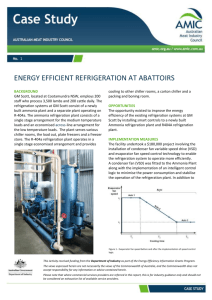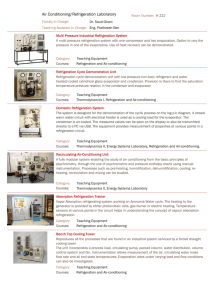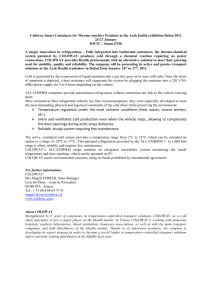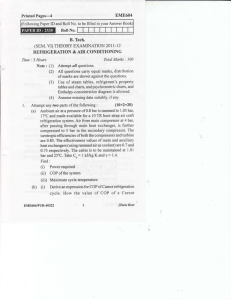A novel approach to improve COP efficiency
advertisement
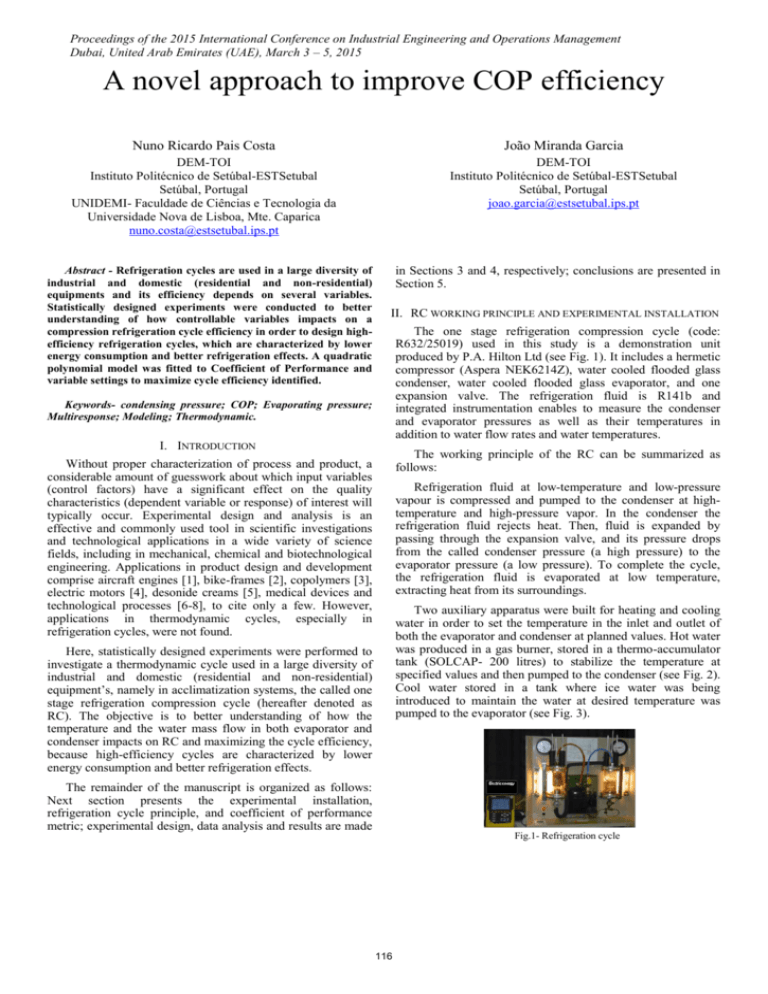
Proceedings of the 2015 International Conference on Industrial Engineering and Operations Management Dubai, United Arab Emirates (UAE), March 3 – 5, 2015 A novel approach to improve COP efficiency Nuno Ricardo Pais Costa João Miranda Garcia DEM-TOI Instituto Politécnico de Setúbal-ESTSetubal Setúbal, Portugal UNIDEMI- Faculdade de Ciências e Tecnologia da Universidade Nova de Lisboa, Mte. Caparica nuno.costa@estsetubal.ips.pt DEM-TOI Instituto Politécnico de Setúbal-ESTSetubal Setúbal, Portugal joao.garcia@estsetubal.ips.pt Abstract - Refrigeration cycles are used in a large diversity of industrial and domestic (residential and non-residential) equipments and its efficiency depends on several variables. Statistically designed experiments were conducted to better understanding of how controllable variables impacts on a compression refrigeration cycle efficiency in order to design highefficiency refrigeration cycles, which are characterized by lower energy consumption and better refrigeration effects. A quadratic polynomial model was fitted to Coefficient of Performance and variable settings to maximize cycle efficiency identified. in Sections 3 and 4, respectively; conclusions are presented in Section 5. II. RC WORKING PRINCIPLE AND EXPERIMENTAL INSTALLATION The one stage refrigeration compression cycle (code: R632/25019) used in this study is a demonstration unit produced by P.A. Hilton Ltd (see Fig. 1). It includes a hermetic compressor (Aspera NEK6214Z), water cooled flooded glass condenser, water cooled flooded glass evaporator, and one expansion valve. The refrigeration fluid is R141b and integrated instrumentation enables to measure the condenser and evaporator pressures as well as their temperatures in addition to water flow rates and water temperatures. Keywords- condensing pressure; COP; Evaporating pressure; Multiresponse; Modeling; Thermodynamic. I. INTRODUCTION The working principle of the RC can be summarized as follows: Without proper characterization of process and product, a considerable amount of guesswork about which input variables (control factors) have a significant effect on the quality characteristics (dependent variable or response) of interest will typically occur. Experimental design and analysis is an effective and commonly used tool in scientific investigations and technological applications in a wide variety of science fields, including in mechanical, chemical and biotechnological engineering. Applications in product design and development comprise aircraft engines [1], bike-frames [2], copolymers [3], electric motors [4], desonide creams [5], medical devices and technological processes [6-8], to cite only a few. However, applications in thermodynamic cycles, especially in refrigeration cycles, were not found. Refrigeration fluid at low-temperature and low-pressure vapour is compressed and pumped to the condenser at hightemperature and high-pressure vapor. In the condenser the refrigeration fluid rejects heat. Then, fluid is expanded by passing through the expansion valve, and its pressure drops from the called condenser pressure (a high pressure) to the evaporator pressure (a low pressure). To complete the cycle, the refrigeration fluid is evaporated at low temperature, extracting heat from its surroundings. Two auxiliary apparatus were built for heating and cooling water in order to set the temperature in the inlet and outlet of both the evaporator and condenser at planned values. Hot water was produced in a gas burner, stored in a thermo-accumulator tank (SOLCAP- 200 litres) to stabilize the temperature at specified values and then pumped to the condenser (see Fig. 2). Cool water stored in a tank where ice water was being introduced to maintain the water at desired temperature was pumped to the evaporator (see Fig. 3). Here, statistically designed experiments were performed to investigate a thermodynamic cycle used in a large diversity of industrial and domestic (residential and non-residential) equipment’s, namely in acclimatization systems, the called one stage refrigeration compression cycle (hereafter denoted as RC). The objective is to better understanding of how the temperature and the water mass flow in both evaporator and condenser impacts on RC and maximizing the cycle efficiency, because high-efficiency cycles are characterized by lower energy consumption and better refrigeration effects. The remainder of the manuscript is organized as follows: Next section presents the experimental installation, refrigeration cycle principle, and coefficient of performance metric; experimental design, data analysis and results are made Fig.1- Refrigeration cycle 116 freezers, industrial cold stores as well as HVAC (heating, ventilating, and air conditioning) equipments and systems [912]. This metric is called Coefficient of Performance (COP) and is defined as Thermo accumulator tank Cold water tank COP = Qevap W elect Water pump The higher the COP value is, the better their performance will be, which can be achieved by reducing energy consumption and increasing the refrigeration power in the evaporator [11], if possible, simultaneously. COP values of compression refrigeration cycles used for domestic and industrial refrigeration vary from 1 to 3 [13]. For the case of small cycles like that of didactic unit employed in this study, expected COP value is equal to 1 or even a bit lower. This means that Q evap and Welect are of similar magnitude. Fig. 2- Heating water system Fig. 3- Cooling water system A. Refrigeration cycle efficiency Refrigeration cycles are used in a wide variety of fields, for example, in food and pharmaceutical industries for refrigeration and conservation, in health services to keep some medicines at low temperature, in domestic and public rooms as air conditioner. For these purposes, electric power must be supplied to obtain the expected refrigeration power. Electric power is the rate of energy consumption in electrical circuits, expressed in Watts, and in this study was measured with an analyser Chauvin Arnoux (Qualistar plus CA 8335), shown in Fig. 1. Refrigeration power is a measure of the heat-extraction capacity of refrigeration and air conditioning equipments and is calculated by applying the first law of thermodynamics to open stationary systems: the total energy of an isolated system is constant; energy can be transformed from one form to another, but cannot be created or destroyed. Considering the schematic representation of inputs and outputs (energy and mass balance) in the evaporator (region delimited by the dash line) shown in Fig. 4, refrigeration power ( Q evap ) can be defined as Q evap m water Cp water (Tout evap Tin evap ) III. DESIGN OF EXPERIMENTS All the controllable variables in the installation unit that impacts knowingly on RC efficiency were included in this study, namely the inlet temperature and the water mass flow in both evaporator and condenser, denoted in this study by T cond (inlet water temperature in condenser), m cond (water mass flow in condenser), Tevap (inlet water temperature in evaporator), and m evap (water mass flow in the evaporator). Supported on authors’ expertise and after preliminary experiments (trial runs), in order to simulate as much as possible real-life operating conditions of RC cycles, the range for the variable settings was setting such as shown in Table I. Notation and variable units are as follows: Q evap – Refrigeration Power (W); m water – water mass flow rate in evaporator (kg/s); Cp water– specific heat of water at constant pressure (3.418 kJ/kgK); Tinevap– inlet water temperature in the evaporator (ºC); Toutevap– outlet water temperature in the evaporator (ºC). The ratio between the refrigeration ( Q evap ) and electric ( Welect ) powers is a metric currently used to assess the refrigeration cycles efficiency of domestic refrigerators and To explore the relationship between the four independent variable (COP) a variables (or factors) and the dependent faced-centered cube design (FCD) was selected. The experimental design consists of a two level full factorial design (24=16 experiments), 8 star points and 4 center points, which allow to estimate the second order and other non-linear components of the relationship between factors and response. Four center points are enough to produce the required design variance stability because the cuboidal region delimited by the factors range represents the region of interest and the region of operability. Factor levels are listed in Table I and experimental design (matrix of experiments) is displayed in Table II. Further information about FCD and other designs can be found in classical books about Design of Experiments or Response Surface Methodology [14-16]. TABLE I. m water Level Maximum Center point Minimum Toutevap Tinevap (2) Fig. 4- Evaporator: Control volume 117 Tcond (ºC) 35 30 25 VARIABLE SETTINGS (g/s) 30 20 10 Tevap (ºC) 24 17 9 (g/s) 30 20 10 10 10 10 10 30 30 30 30 10 10 10 10 30 30 30 30 20 20 10 30 20 20 20 20 20 20 20 20 Tevap 9 9 24 24 9 9 24 24 9 9 24 24 9 9 24 24 17 17 17 17 9 24 17 17 17 17 17 17 10 30 10 30 10 30 10 30 10 30 10 30 10 30 10 30 20 20 20 20 20 20 10 30 20 20 20 20 COP 0.448 0.554 0.739 1.097 0.459 0.548 0.780 0.992 0.447 0.587 0.922 0.906 0.394 0.529 0.904 1.016 0.768 0.760 0.706 0.826 0.378 0.727 0.708 0.736 0.752 0.747 0.751 0.796 Variables and Interactions x3 x32 x4 183 185 185 187 186 187 184 186 191 192 204 215 191 194 208 212 187 198 184 182 181 188 193 195 191 183 182 189 x42 x1x2 x1x3 x1x4 x2x3 x2x4 x3x4 Tevap Tevap x Tevap Coefficient 0.208 -0.141 0.065 Std. Error 0.016 0.042 0.016 t(13) 13.097 -3.360 4.073 0.015 0.002 0.012 -0.025 0.009 -0.003 0.042 0.017 0.017 0.017 0.017 0.017 0.363 0.138 0.710 -1.461 0.534 -0.151 p 0.000 0.005 0.001 0.722 0.892 0.490 0.168 0.602 0.883 0.012 0.017 0.705 0.493 x Tcond x Tcond x Tevap Tcond x x Tevap x Tevap x 3.0 2.5 .99 2.0 .95 1.5 Expected Normal Value Tcond 25 25 25 25 25 25 25 25 35 35 35 35 35 35 35 35 25 35 30 30 30 30 30 30 30 30 30 30 MATRIX OF EXPERIMENTS AND RESULTS 1.0 .75 0.5 .55 0.0 .35 -0.5 -1.0 .15 -1.5 .05 -2.0 .01 -2.5 -3.0 -0.20 -0.15 -0.10 -0.05 0.00 0.05 0.10 0.15 Residual Fig. 5- Normal Probability Plot 0.15 0.10 0.05 Raw Residuals TABLE II. IV. DATA ANALYSIS AND RESULTS 0.00 -0.05 -0.10 The designed experiments were run in the thermodynamic laboratory of Setubal Polytechnic Institute – ESTSetubal, and the response results are presented in Table II. The data were analysed using the statistical software STATISTICA® and second order models fitted to COP based on analysis of variance (ANOVA) results. The estimated regression coefficients are given in Table III, and the model fitted to COP is as follows: -0.15 -0.20 0.3 x1 x12 x2 x22 Mean/Interc Tcond Tcond x Tcond x Std. Error 0.023 0.016 0.042 0.016 0.042 t(13) 30.696 0.267 1.350 0.142 1.409 0.7 0.8 0.9 1.0 1.1 0.10 Raw Residuals 0.05 0.00 -0.05 -0.10 -0.15 -0.20 -5 0 5 10 15 20 25 30 35 Case Number Fig. 7- Residuals and Run order From model fitted to COP, one can see that linear effects of Tevap (x3) and m evap (x4) are the most important to maximize this response. Between them, x3 has the greatest impact, and its coefficient is almost 3.3 times greater than that of x4. ESTIMATED REGRESSION COEFFICIENTS Coefficient 0.716 0.004 0.057 0.002 0.059 0.6 0.15 This model explains 91.5% of the variation in the data (Adjusted R-sqr = 0.915), and the significant effects on response are at bold-face values in Table III. Graphical residual analysis, presented in Fig. 5-7, does not show violations of ANOVA assumptions (residuals Normality, Independence, and Homoscedasticity). It includes linear and quadratic terms as well as an interaction term as significant statistically. Variables and Interactions 0.5 Predicted Values ̂ = 0.716858 + 0.207645 x 3 + 0.064669 x4 + 0.060942 x12 + 0.063435 x 22 – 0.136985 x32 – 0.024575 x1 x 4 TABLE III. 0.4 Fig. 6- Residuals and Predicted values In practice, the greater x3 value is, the higher cycle efficiency (COP value) will be, though its quadratic term ( x32 ) p 0.000 0.794 0.200 0.889 0.182 has a negative influence in COP. The interaction x1x4 (Tcond x ) is significant, but its coefficient is 2.6 times smaller 118 TABLE IV. than that of x12 and 2.4 times smaller than x12 (Tcond x Tcond) and x 22 ( x Tcond 25 25 ). These experimental results are in accordance with the theoretical ones, since it is known that evaporator temperature is the most important parameter regarding to COP [17]. The theoretical influence of evaporator temperature is also reflected in the presented results through the influence of the water mass flow rate in evaporator. The effects of these parameters are visible in the significant effects of x3 and x4, which are the most relevant parameters to maximize the COP. Also the maximum value obtained for COP is in accordance with the expected value (COP=1) for this small didactic refrigeration cycle [13]. 30 30 CONFIRMATORY EXPERIMENTS Tevap 22.3 22.3 30 30 COP 0.93 0.90 188 183 ACKNOWLEDGMENT The authors thanks to IPS-ESTSetubal for providing the didactic refrigeration cycle and all the other instrumentation, and to the Mr. Vitor Pinho for his contribution in the experimental part of this research. REFERENCES [1] To confirm the value achieved with the model fitted to COP (COP = 1.01), two confirmatory experiments were run at optimal variable settings [xi=(25, 30, 22.3, 30)]. Results are presented in Table IV, and one can see that variance in the experimental results is small and COP values are in agreement with theoretical results. Thus, one can argue that second-order model fitted to COP was adequate to better understand the influence of the selected operating variables on the refrigeration cycle performance. [2] [3] [4] [5] V. CONCLUSIONS Statistically designed experiments were performed and results analyzed with the objective of maximizing the efficiency of a compression refrigeration cycle, using a didactic installation. A second order model was fitted to Coefficient of Performance and considerable benefits results from it. Most of all, it provides an estimate of the response and the functional relationship between design variables and the response at any point within the experimental region is provided, which is useful for refrigeration cycle design and operation purposes. [6] [7] [8] [9] All input variables have a statistically significant effect on Coefficient of Performance, and are included in the response model. Except the inlet water temperature in the condenser, which must be set at low level, study results suggest that the remaining parameters must be set at high level or close of it. Confirmatory experiments validated these results. [10] [11] The application of Response Surface Methodology to investigate refrigeration cycles is a novel approach in thermodynamics and as future research we plan to apply this methodology in domestic and industrial equipments as well as in other thermodynamic cycles. Simultaneous optimization of models fitted to refrigeration and electric power responses is another alternative approach to better understand and maximizing cycle efficiency. To test other refrigeration fluids and types of compressor devices can also be considered in future studies. [12] [13] [14] [15] 119 R. Tappeta, S. Nagendra, and J. Renaud “A multidisciplinary design optimization approach for high temperature aircraft engine components,” Struct. Optim., vol. 18, pp. 134-145, 1999. A. Jeang, F. Liang, and C. Chung, “Robust product development for multiple quality characteristics using computer experiments and an optimization technique,” Int. J. Prod. Res., vol. 46, 3415-3439, 2008. I. Ilbay and N. Çelik, “A statistical and experimental investigation on product design for copolymer based multichannel polyester draw textured yarns,” J. Textile and Apparel, vol. 19, pp. 291-298, 2009. E. Gijio and J. Scaria, “Product design by application of Taguchi's robust engineering using computer simulation,” Int. J. Comp Integ Manuf, vol 25, pp. 761-773, 2012; S. Lopes, J. Sarraguça, J. Prior, and J. Lopes, “Development of an HPLC assay methodology for a desonide cream with chemometrics assisted optimization,” Analytical Letters, vol. 45, pp. 1390-1400, 2012. D. Dixon, D. Eatock, B. Meenan, and M. Morgan, “Application of design of experiment techniques to process validation in medical device manufacture,” J Valid Technol, vol. 12, pp. 92-100, 2006. J. Vlachogiannis, “Taguchi's technique: An effective method for improving X-ray medical radiographic screen performance,” Proceedings of Institution of Mechanical Engineering, Part H: J. Eng. Medicine, vol. 217, pp. 375-384, 2003. D. Steinberg and D. Bursztyn, “Response surface methodology in biotechnology,” Qual. Eng., vol. 22, pp. 78-87, 2010. J. Dabas, A. Dodeja, S. Kumar, and S. Kasana, “Performance characteristics of vapour compression refrigeration system under real transient conditions,” Int. J. Advanc Technol, vol. 2, pp. 584-593, 2011. S. Pfister, “Transient modeling of vapor compression refrigeration systems using measured compressor COP. In: International Refrigeration and Air Conditioning Conference. Paper 653, 2004. Available at http://docs.lib.purdue.edu/iracc/653. I. Dincer , Refrigeration Systems and Application. London: John Wiley & Sons Ltd, 2004. A Mackensen, S. Klein, and D. Reindl, Characterization of refrigeration system compressor performance. In: International Refrigeration and Air Conditioning Conference, Paper 567, 2002. Available at http://docs.lib.purdue.edu/iracc/567. E. Bjork, Energy efficiency improvements in household refrigeration cooling systems. PhD Thesis, Royal Institute of Technology, UK, 2012. G. Box, J. Hunter, and W. Hunter, Statistics for Experimenters: Design, Innovation, and Discovery. New Jersey: John Wiley & Sons, 2005. R. Myers, D. Montgomery, and C. Anderson-Cook, Response Surface Methodology: process and product optimization using designed experiments. New Jersey: John Wiley & Sons, 2009.



